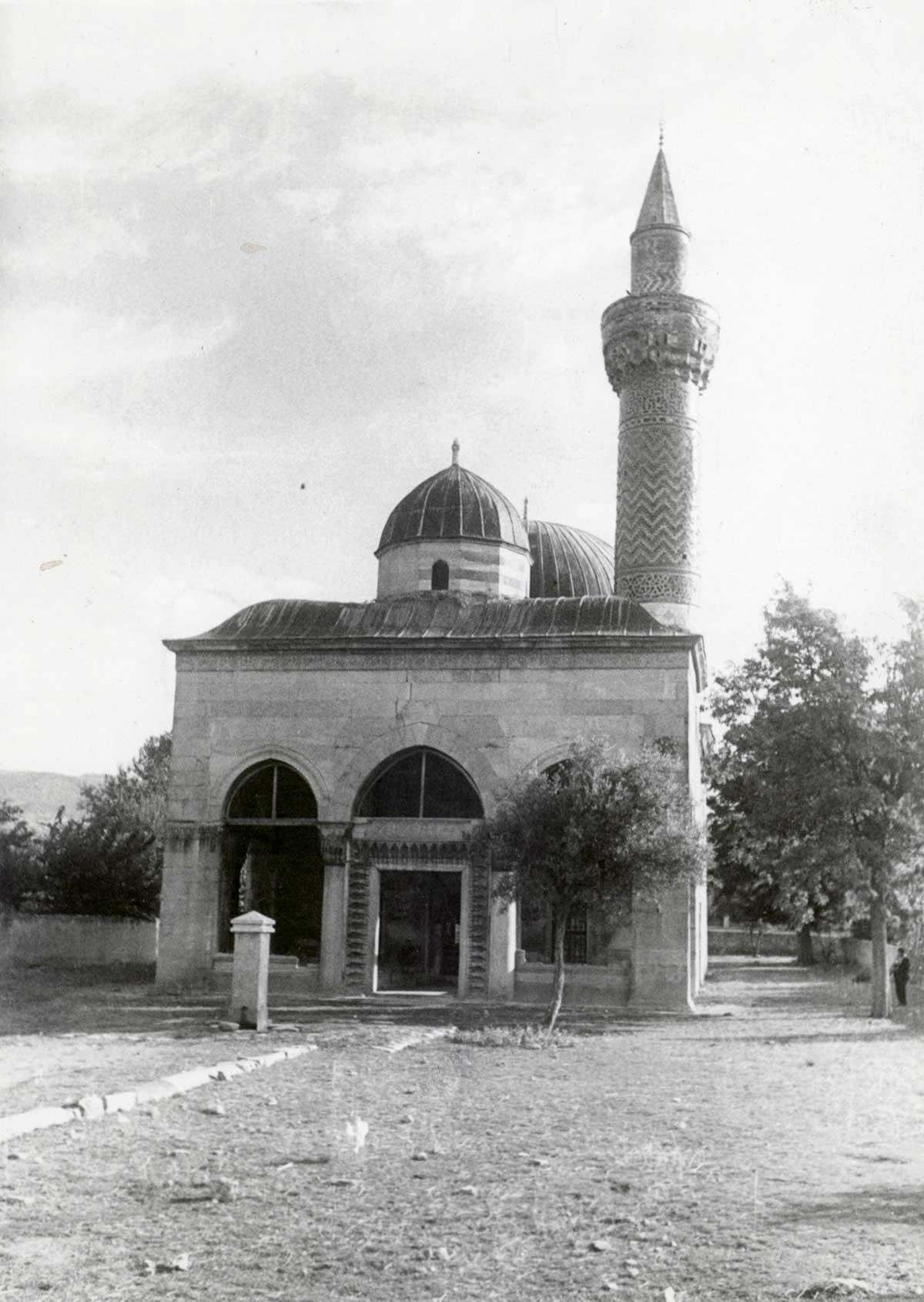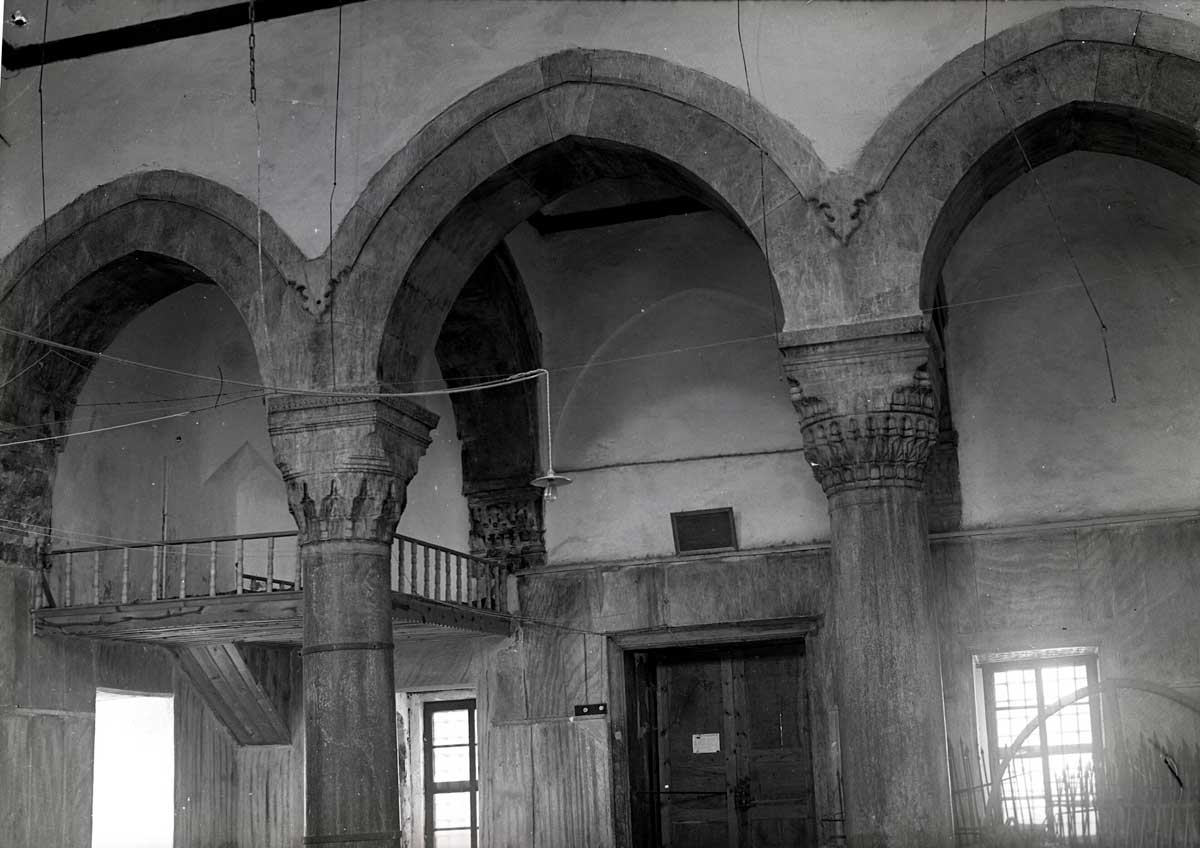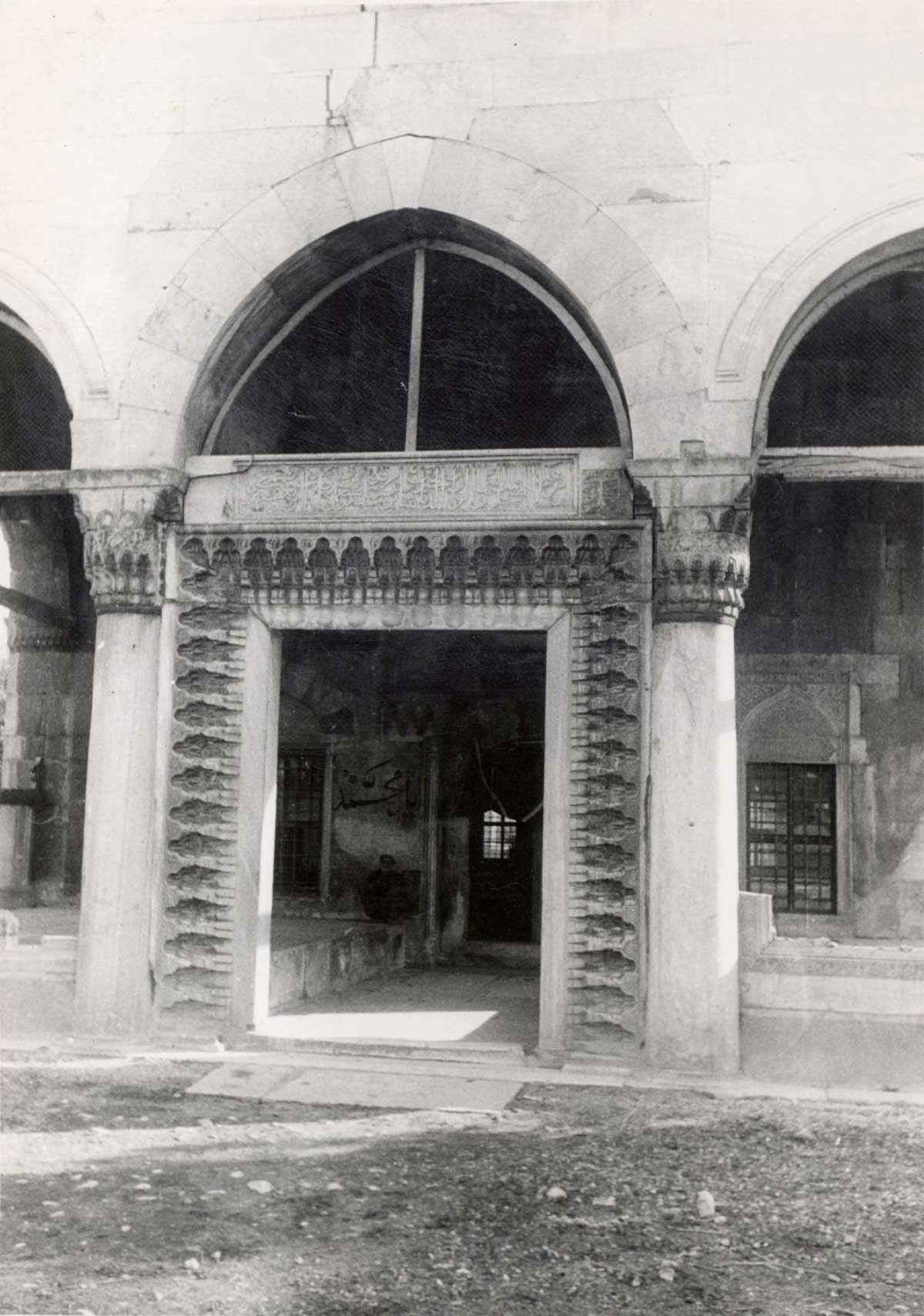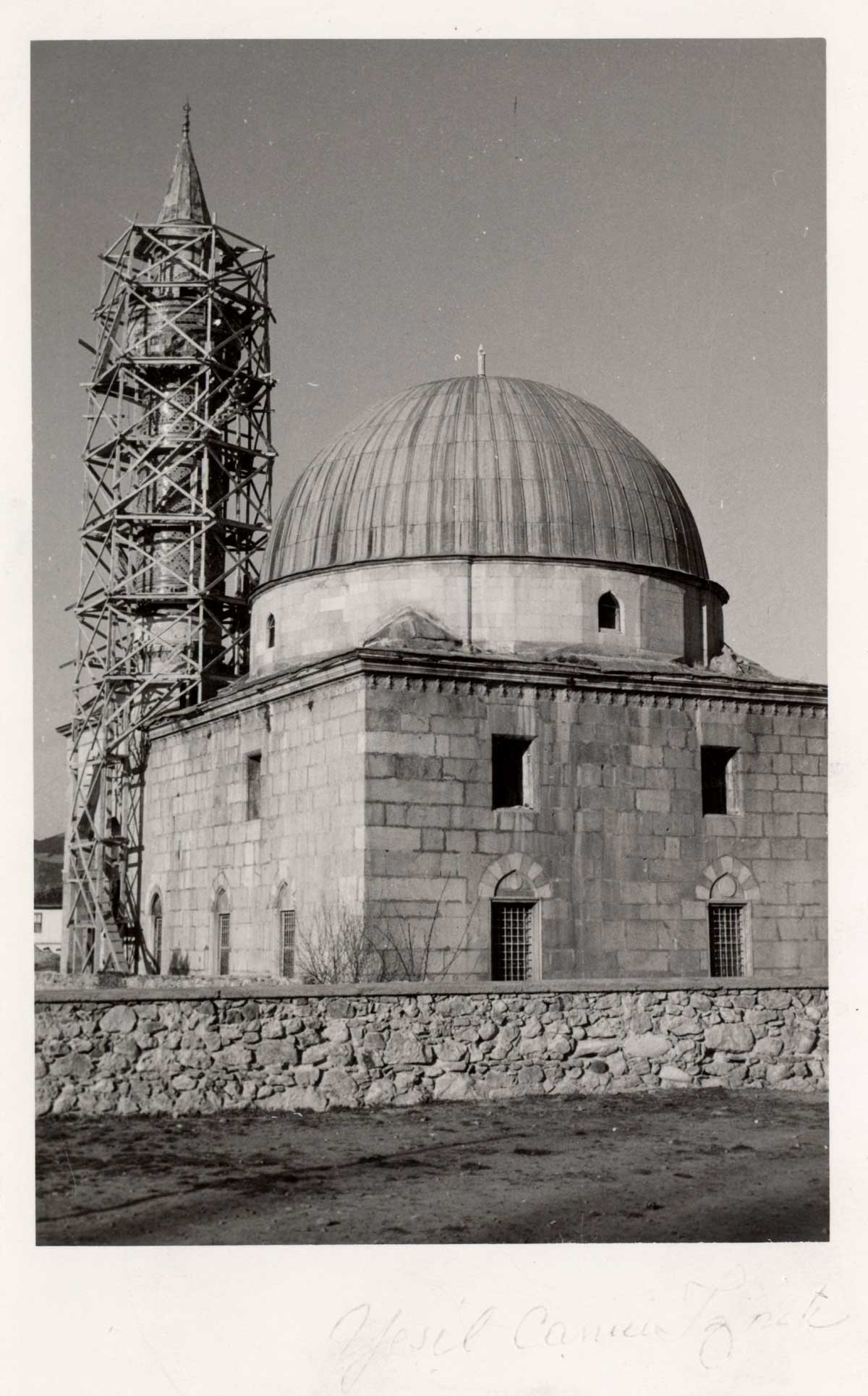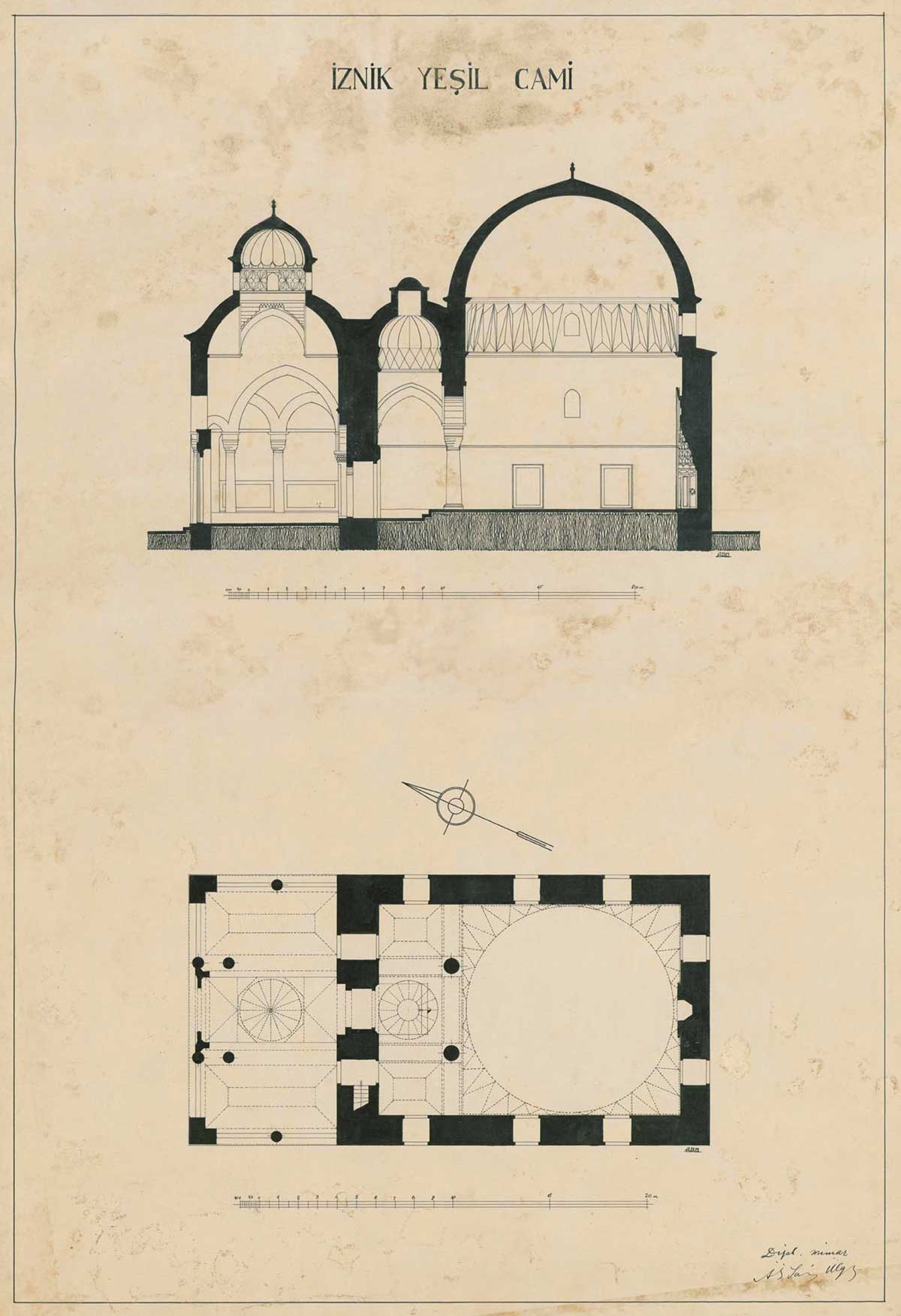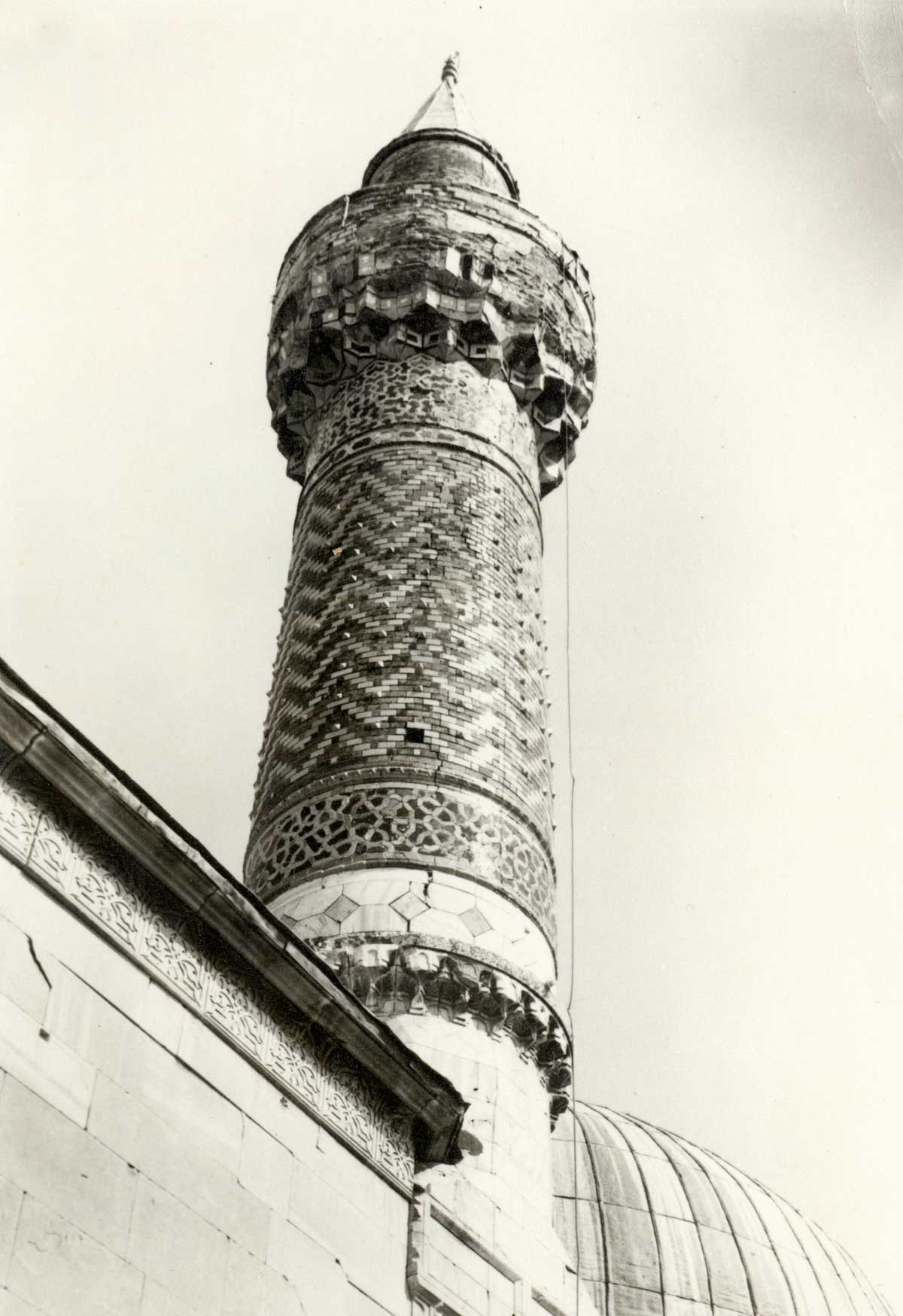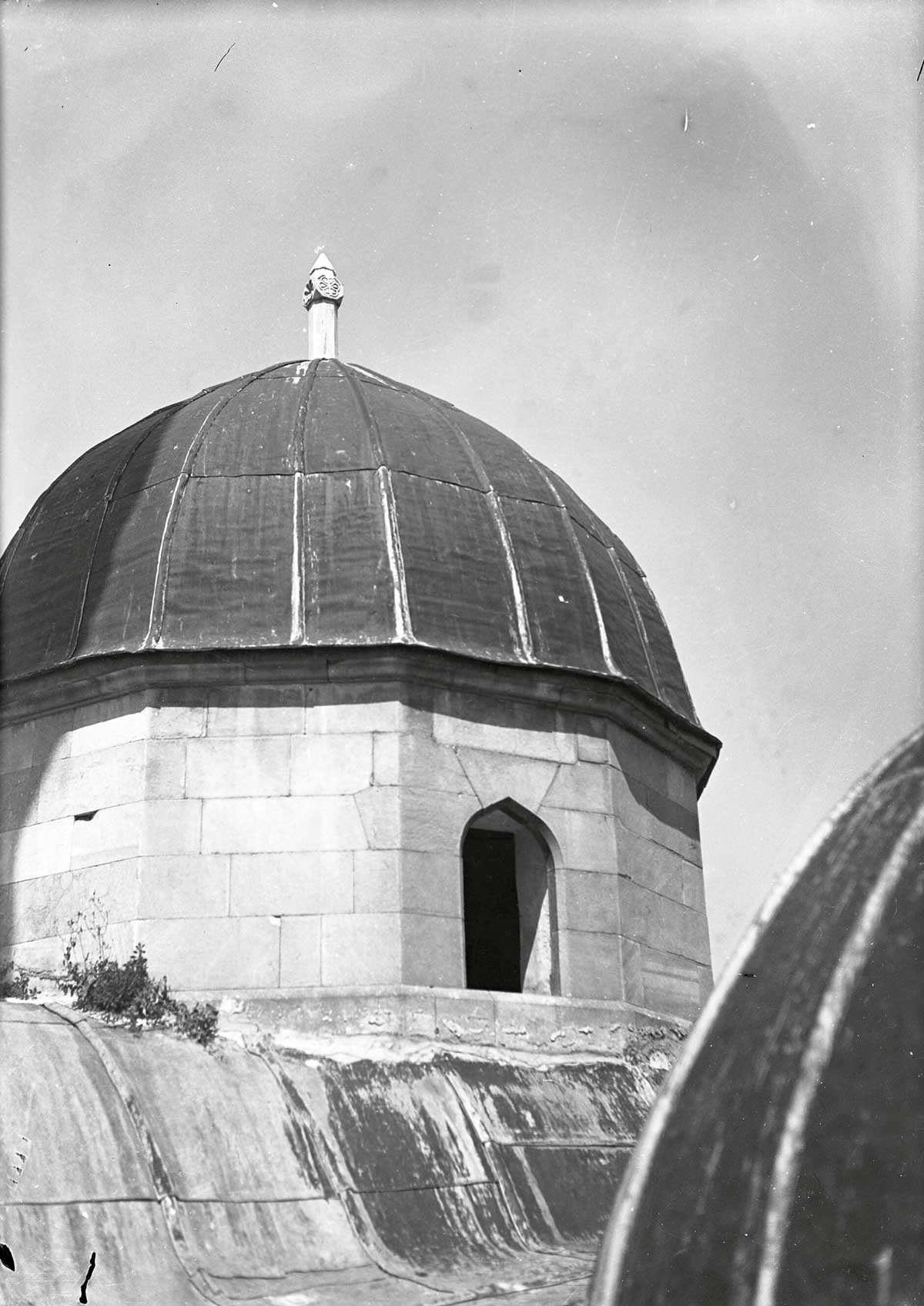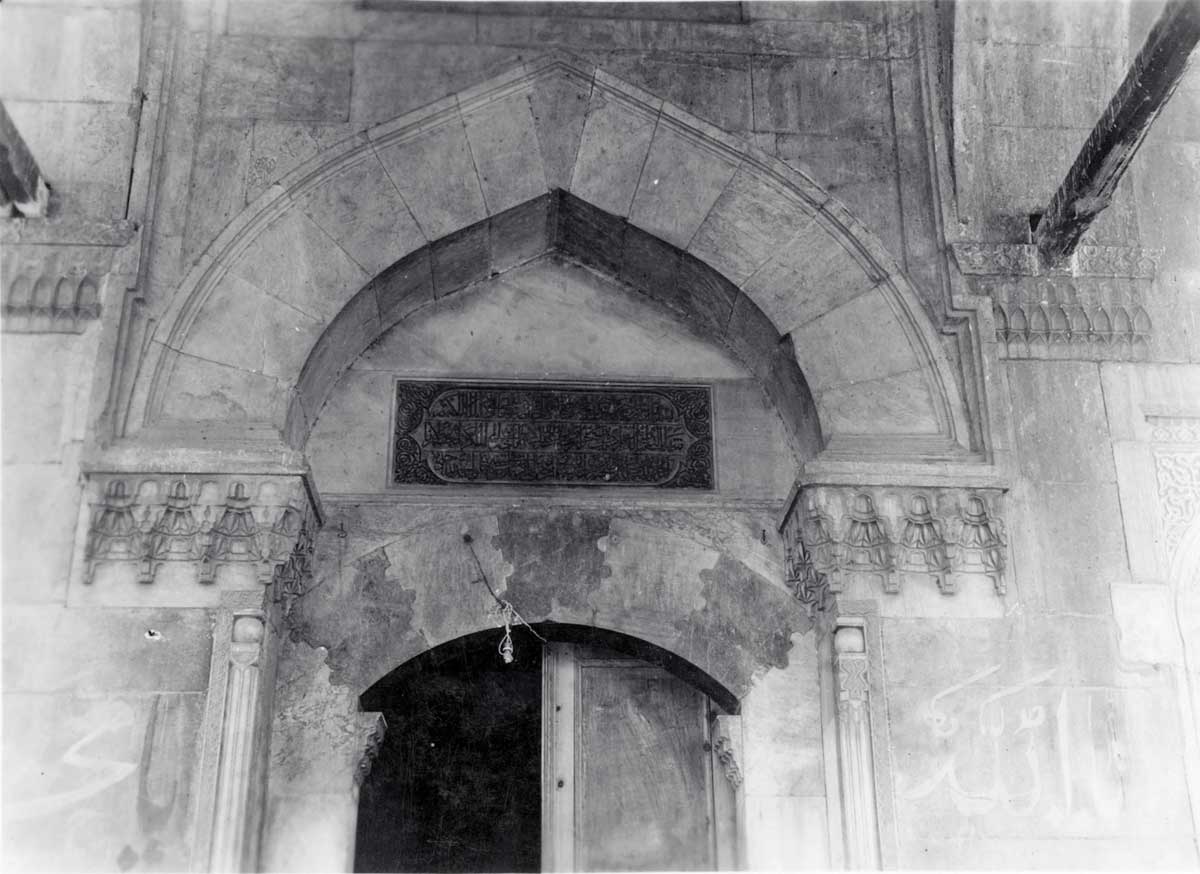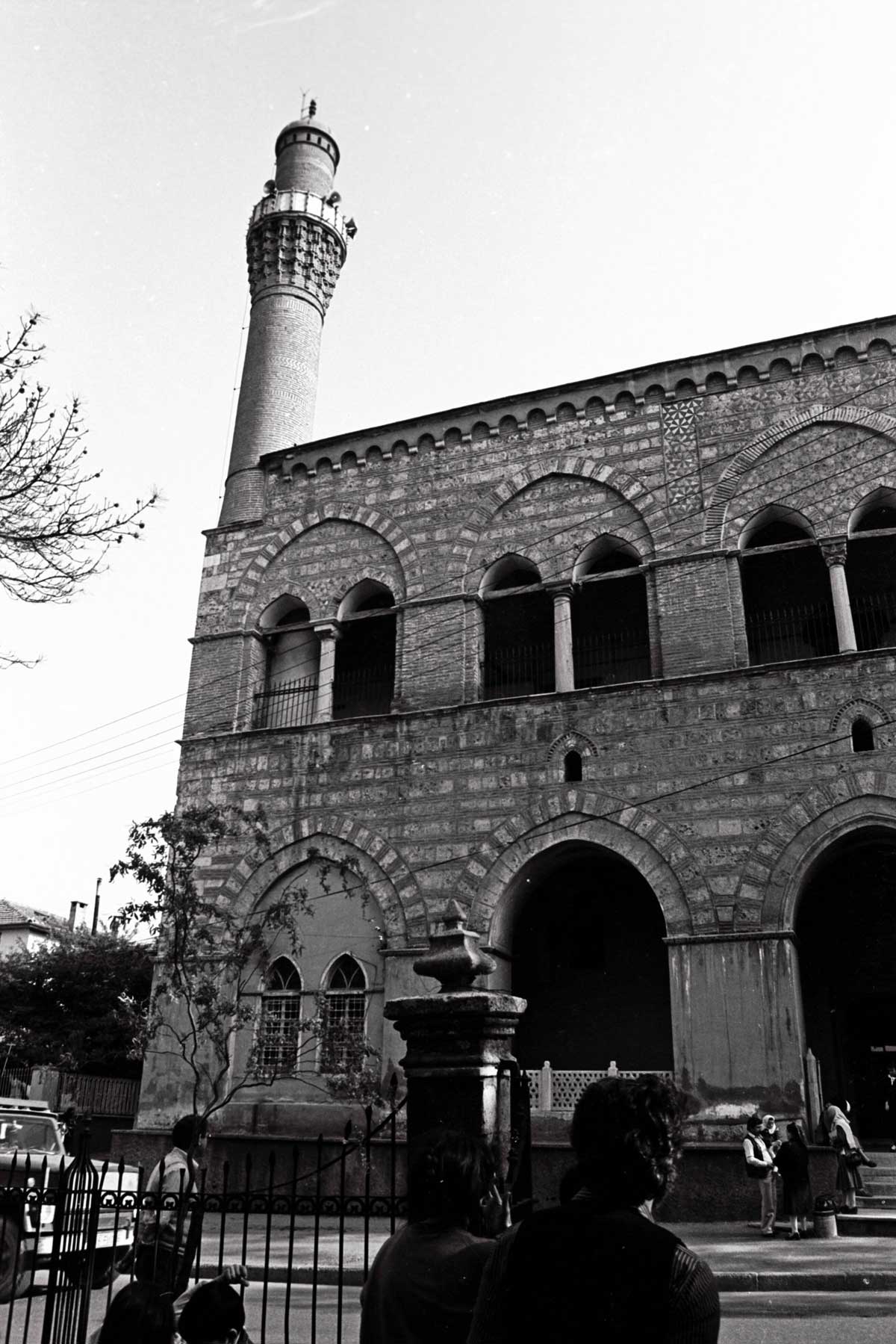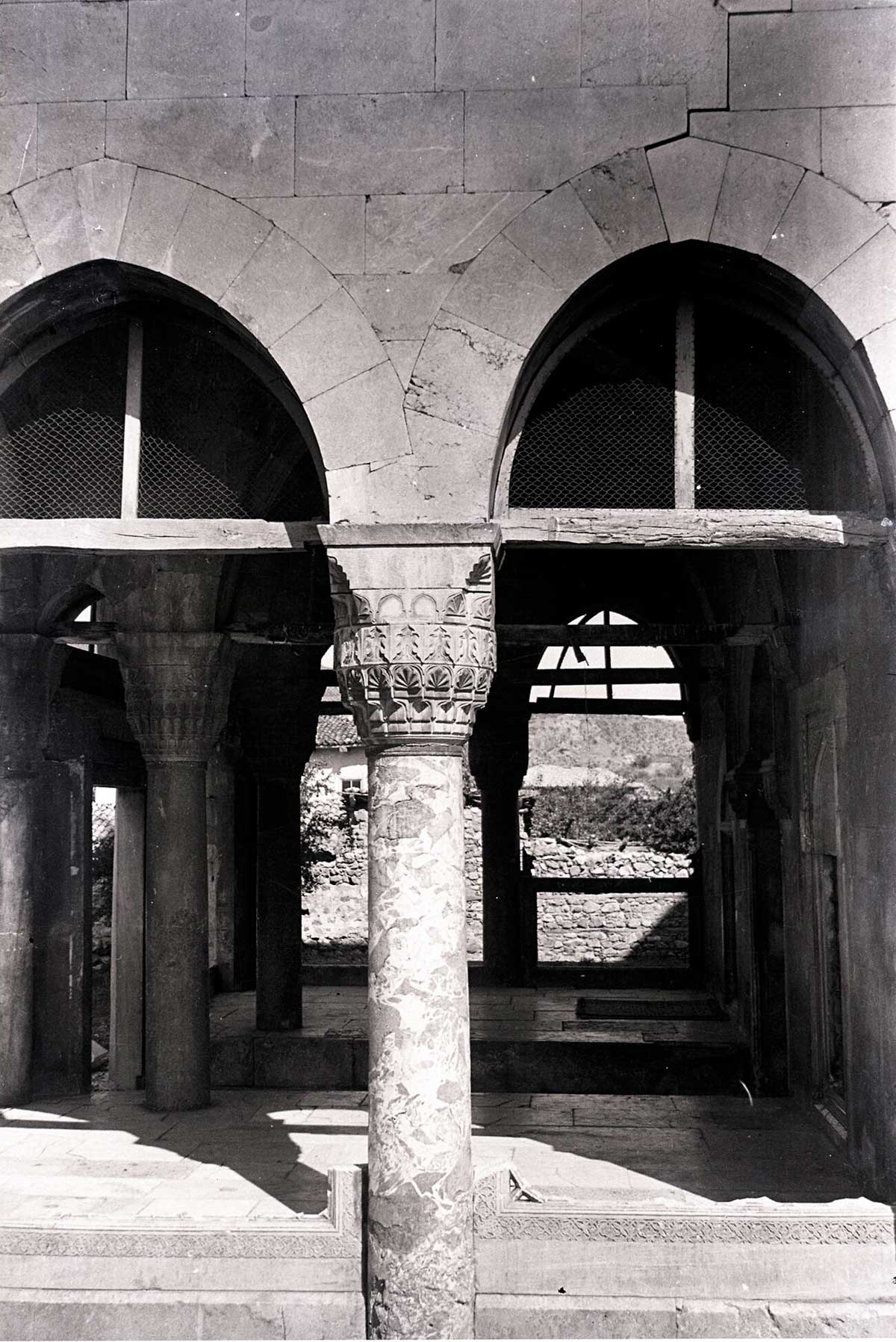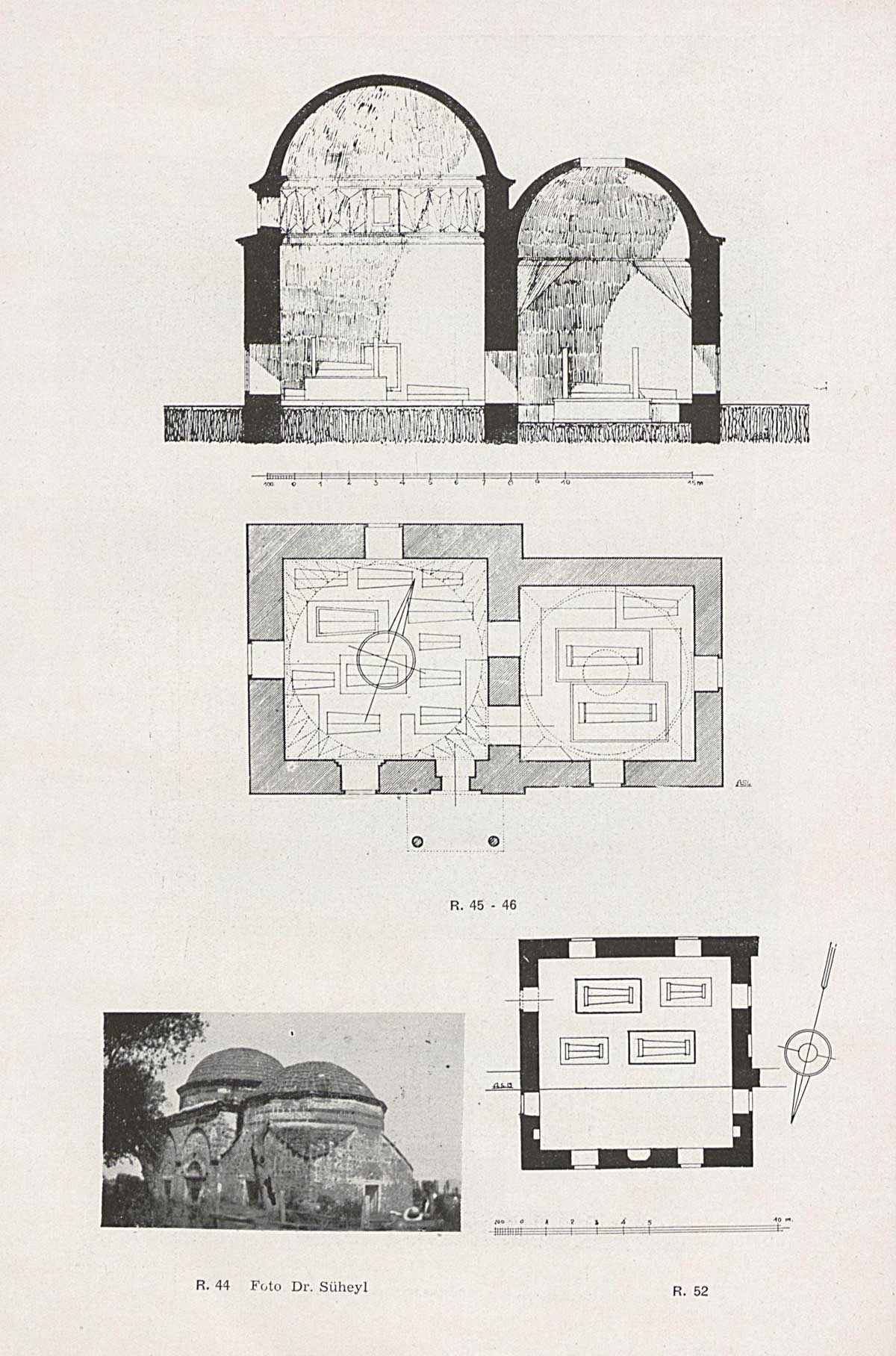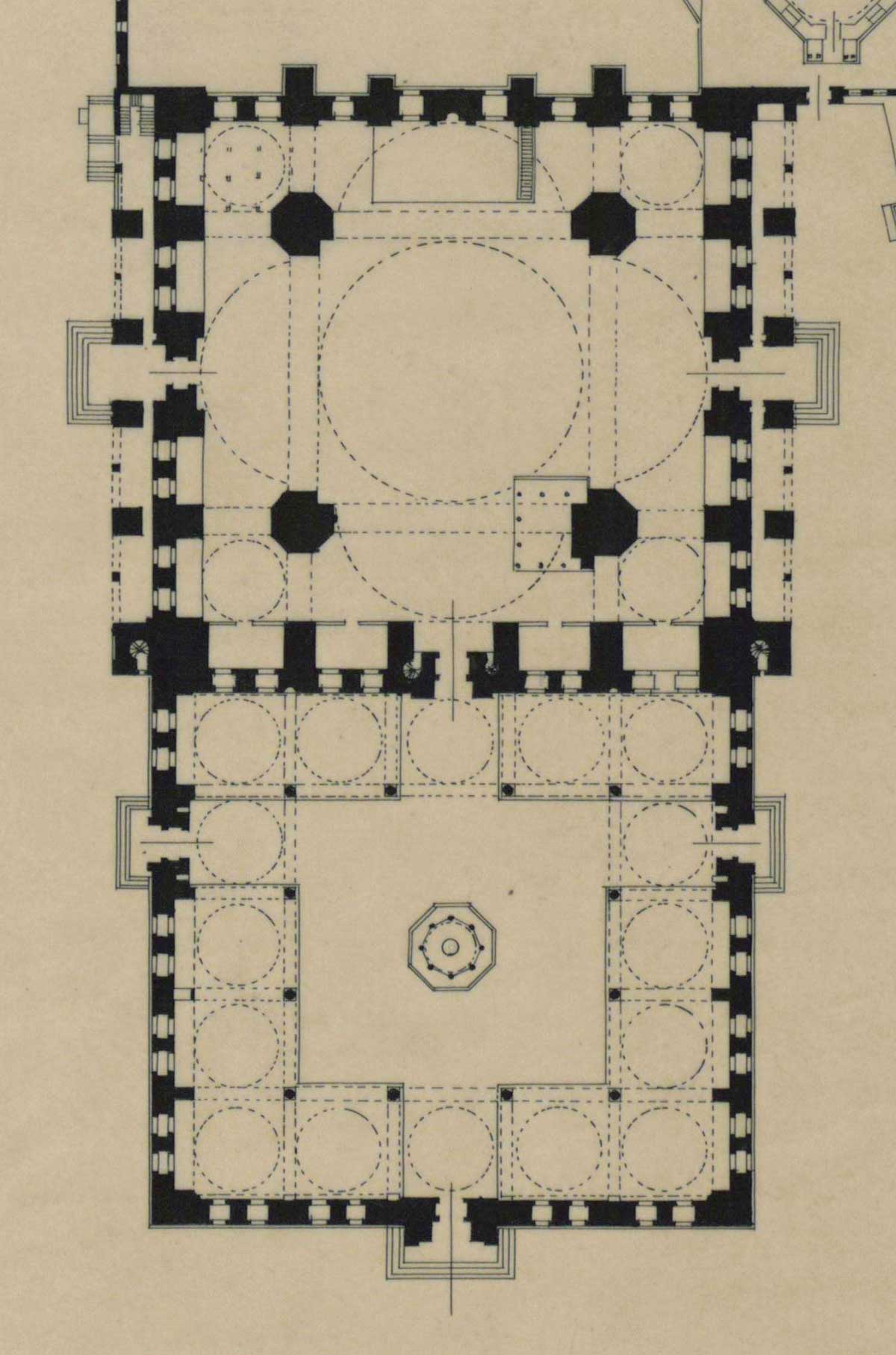Introduction
Commissioned by Çandarlı Kara Halil Hayreddin Pasha (1364–1387), an officer who held the title of Grand Vizier in the new Ottoman state,1 the Yeşil Camii (Green Mosque) was built between 1378 and 1391 in İznik (Nicaea).2 Little is known about the architect, Hacı bin Musa, who built the mosque. Nevertheless, Musa’s design continued its initial function as a mosque serving the Muslim community in İznik over the course of the entire Ottoman Empire (Figures 1, 2, 3).
The Green Mosque in 1946, its run-down condition evident. ASÜA, SALT. https://archives.saltresearch.org/handle/123456789/78893.
View of the Green Mosque’s vestibule with the elevated lodge. Photograph taken in 1938 or earlier: Note the marble column with iron clamps: From Ülgen (1938: R16).
Door frame of the portico with the demolished balustrades. Photograph taken in 1946. ASÜA, SALT. https://archives.saltresearch.org/handle/123456789/78893.
The defeat of the Ottoman Empire in World War I annihilated the imperial state and involved massive destruction within the war fronts: Gallipoli, Levant, and Mesopotamia. After the 1918 Armistice, the empire came under extensive occupation by the Allied powers (Armenia, Greece, France, and the United Kingdom) and lost its sovereignty. During this occupation era, Mustafa Kemal Atatürk (1881–1938), the emergent leader of the Kuva-i Milliye (nationalist liberation movement), formed a coalition against the foreign takeover of Anatolia.3 The resulting battles of the Turkish War of Independence (1919–1923) were fought on the western, eastern, and southeastern fronts to liberate the regions from the occupation of the Allies.
When Atatürk and the military-bureaucratic cadre proclaimed a republic after defeating the Allies, the magnitude of destruction of built heritage presented a major challenge. The built environment had suffered from years of neglected repair and maintenance, and entire segments of architecture had been lost in regions at the war front. In addition, many buildings and their urban and topographic settings in İznik had already been destroyed during the Greek occupation from 1919 to 1922.
During the occupation, the Greek army had stored wood in the Green Mosque. When the Greek army retreated from the Turkish nationalist liberation forces, they initiated an arson attack in the city, burning the wood inside the mosque. The locals extinguished the fire, rescuing one of the marble columns by strapping it with iron clamps (visible in Figure 2) (M. Ç. 1939: 6). Overall, the mosque was excessively mauled (see Figures 1, 2, and 3), its mihrab, minbar, geometrically patterned balustrades, and stalactite4 frames demolished (‘İznik’te Kıymetli’ 1937: 7; Goodwin 1971: 20). After the proclamation of the Republic of Turkey in 1923, no funding was available for the Green Mosque due to budgetary constraints; in the late 1930s it was still in ruins, awaiting to be repair (‘İznik’teki Eserler’ 1935: 15; 1937: 7). With the institutionalization of historic preservation agencies in the republican state, the building received funds for repairs over the years. Between 1956 and 1969, the Vakıflar Genel Müdürlüğü (General Directorate of Pious Foundations) restored the mosque to its authentic configuration as it had been captured in historic photographs (Naza-Dönmez 2008: 810) (Figure 4).5
View of the mihrab-wall during restoration in 1957. ASÜA, SALT. https://archives.saltresearch.org/handle/123456789/85624.
In the early republic, nationalist leaders signified the Turkish collective mind as the country’s binding identity. The founding ideology of the nation-state, Türk Tarih Tezi (Turkish History Thesis), was an attempt to identify a pure national spirit among Turks in all periods of history. Afet İnan (1908–1985), a historian and sociologist, specified the roots of the Turkish nation as being in Central Asia, where Turks had lived thousands of years before (1933: 31). Due to droughts and wars, Turks migrated to the east and the west, carrying their culture to India, China, Mesopotamia, Anatolia, Europe, and Africa. The Turkish History Thesis thus embodied three overlapping themes: Turks were the ancestors of the Indo-Europeans; Turks had contributed to the civilizations along migration routes; and Turks were the indigenous inhabitants of Anatolia, the true Turkish motherland (Çağaptay 2006: 51).
According to the historicist reading of the Turkish History Thesis, the faith of Islam was irrelevant in defining the culture of the Turkish race. Although Muslim dynasties of Seljuks, Beyliks, or Ottomans represented the Islamic community, to which Turks belonged by religion, it was specifically an individual Turkish culture, distinct from other Muslim cultures.6 In the aftermath of Atatürk, a secular appraisal of the thesis substituted for a religious-ethnic reading, which subsequent governments have extensively exploited. Monuments associated with an Islamic past came to the foreground and constituted the basis for a new collective memory. The defining historic moments were, first, the defeat of the Byzantines in the Battle of Malazgirt (Manzikert)7 of 1071, which prompted the Seljuk-Turks to pour into Anatolia and create their homeland, and then the Ottoman conquest of Constantinople in 1453, which sealed the end of the Byzantine Empire. Ideologically stressed as ‘Turkish’, the Ottoman roots became a major source of pride for the nation.
In the conflicting camps of the secular-ethnic identity politics of the Turkish History Thesis and the religious-ethnic grounds of Islamification, the common thread in each was the search for the soul of Turkish architecture (Akboy-İlk 2020a; 2020b; 2022). The genealogy of Turkish architecture essentialized a national spirit of pure forms, distinguishing it from Byzantine as well as other Islamic schools of architecture, such as Arab, Egyptian, or Persian. In the continuous historical experience from the early civilizations of Central Asia to the frontiers of Seljuk Anatolia and Ottoman Istanbul, Turkish elements were claimed to be embodied in diverse places — the tents of Turkic nomads, monumental portals of medieval Anatolia, or Architect Sinan’s 16th-century mosques.
İznik’s Green Mosque, because it materialized during the rise of the Ottoman dynasty, became a recurring theme in architectural texts. As early as 1938, Ali Saim Ülgen (1913–1963), an architectural historian and restoration architect, published a monograph on the built environment of İznik, İznik’te Türk Eserleri. In 1937, while a student architect at the prestigious Academy of Fine Arts in Istanbul, Ülgen documented the architectural heritage in İznik to alleviate the lack of publications on the Ottoman history of the ancient city and to secure restoration funds (Figure 5). Ülgen notes the lack of studies on the Green Mosque, saying that ‘despite its significant place in the history of Turkish architecture, our monument has been neither surveyed nor its value recognized’ (1938: 56).
Measured drawings of the Green Mosque, from 1938 or earlier. ASÜA, SALT. https://archives.saltresearch.org/handle/123456789/74606.
In acknowledgment of the lack of information about the mosque that Ülgen identified, miscellaneous reviews of the Green Mosque were published in the years to come. Ekrem Hakkı Ayverdi (1899–1984), a restoration-engineer and historian, dedicates a section to its architectural description in his highly acclaimed Osmanlı Mi’marîsinin ilk Devri (1989: 309–319). Ayverdi defines the Green Mosque as ‘a diamond solitaire’ shining among the monuments of the historic city (1989: 309). The Green Mosque, with its tiled minaret spiraling inside an exterior wall (Figure 6), marked the evolution of minaret design in Ottoman architecture (Ayverdi 1985: 69). Oktay Aslanapa (1914–2013), a scholar of art history, describes the Green Mosque as a ‘transitional structure’ that links Seljuk forms to Ottoman architecture (1971: 193). With its stalactites surrounding the door frame, its pointed roof over the brick minaret, and the green tiles that give the mosque its name, the building carries Seljuk building traditions. Yet the unadorned mihrab with corner plasters, a plain stalactite niche, and geometrical motifs constitute the earliest example of the Ottoman classical decoration program. Likewise, Aptullah Kuran (1927–2002), an architect and historian of architecture, interpreted the Green Mosque on the basis of its domed-square unit, and states that the 14th-century building ‘forecast the direction of development that the Ottoman mosque was to take during the next two centuries’ (1968: 202). The Green Mosque provided the modular unit (inner space bordered by four walls) upon which Ottoman architects would base their mosque designs (Kuran 1968: 213).
View of the minaret. Undated. ASÜA, SALT. https://archives.saltresearch.org/handle/123456789/79801.
However, these authors muted any actual history of their culture’s architecture by their zealous dedication to expressing its origins. To be able to read the history of architecture, historians need to conceptualize symbolic buildings in terms of the historical and socio-cultural conditions that brought them into being, which the naïve approach of these authors failed to do. This study therefore looks at publications over 60 years, from the proclamation of the republic in 1923 to the domination of Türk İslam Sentezi (Turkish-Islamic Synthesis) in the 1980s, to reveal the state of that architectural discourse. The Kemalist era, which ended in 1938, signified the first time a scientific discourse on architecture had thoroughly permeated state propaganda. Growing scholarship resulted in a fair degree of coordination with international developments at that time through the tremendous state support of archaeology, architectural documentation, and historical research. The changing ideological character after Atatürk deprived the state agencies’ patronage of academic research at the highest level, and the groundswell of architectural scholarship that had begun in the early republic regressed. The focus transitioned to the architectural heritage created by the hands and minds of Muslim Turks. Ultimately, the Turkish-Islamic Synthesis came to dominate the historical discourse.
Architectural Description of the Green Mosque
The Green Mosque is a single-unit mosque whose interior space includes a square prayer hall and a rectangular three-bay vestibule. The prayer hall is covered by a hemispherical dome, eleven meters in diameter, that rests on a polygonal drum, which in the interior is decorated with a frieze of prismatic Turkish triangles and is pierced by three arched windows. Eight rectangular windows pierce the walls of the square hall and two flank both the door and the mihrab, for a total of twelve wall windows. The vestibule is covered by flat-topped cross-vaults, and the center bay has a pointed unperforated lantern on top. A three-bay exterior portico is annexed to the main body. Its side bays are also surmounted by flat-topped cross-vaults, while its center bay has an additional frieze of Turkish triangles supporting a fluted dome rising from a high octagonal drum. This dome rises above the portico and is easily seen from the outside (Figures 7, 8).
Octagonal drum of the fluted dome seen from outside. Photograph taken in 1938 or earlier. From Ülgen (1938: R:24).
Interior view of the fluted dome, 1961. Harika and Kemali Söylemezoğlu Archive, SALT. https://archives.saltresearch.org/handle/123456789/78514.
The vestibule fronts the mahfel (elevated lodge). In one corner of the elevated lodge (visible in Figure 2), seventy-seven steps within the wall lead up to the minaret. To support the built-in minaret, this wall is two meters deep, thicker than the other walls by approximately one-third. The minaret is set on a brick and stone base (visible in Figures 4 and 6). The shaft is made of brick and is decorated with yellow, green, turquoise, and dark purple–glazed terra-cotta. The stone şerefe (balcony) rises on stalactites.
The portal of the mosque is flanked by decorative pillars. Its frame is bordered with a pointed arch above, which rises from ashlar impost blocks decorated with stalactites. Inside the pointed arch, an inscription, dated 1378, notes the reign of Murad I and identifies Çandarlı Kara Halil Hayreddin Pasha as a scholar of jurisprudence (Figure 9). In the three-bay portico, the frame of a false door (visible in Figure 3) is set in the central arch. The door frame is flanked by two columns and is bordered by stalactites. Above the stalactite frame is a second inscription panel, dated 1392. Commissioned by Çandarlızade Ali Pasha (s.1387–1406) after his father’s death, the inscription notes the late statesman’s viziership (Ayverdi 1989: 319).
Centralized arch above the portal of the Green Mosque. Photograph taken in 1938 or earlier. From Ülgen (1938: R:22).
Inside the mosque, the mihrab is of finely chiseled marble, bordered by an unadorned frame that is flanked by a column on each side. Above the mihrab is an acroterion with rumi-styled motifs. The pentagonal mihrab niche also has a column on each side. In the three-paneled mihrab, a rumi pattern borders another inscription panel. Below, a geometrical motif surrounds the layered stalactites. Each mihrab panel has a rosette. The wooden minbar is not original. The first minbar, which had burned, was made of wood with dovetailed joints and was carved with grift, reliefs, and inlaid forms comparable to its Seljuk peers (Altan 1936: 2).
The minaret base, door jambs, and capitals of the columns are made of marble. The exterior of the building is of ashlar-limestone, while the interior is finished, up to a height of 3.30 meters, with large plates of textured marble.
Revitalization of İznik after the Ottoman Conquest
In the 14th century, the Ottoman state was a small beylik (principality) on the frontiers of the Islamic world in northwestern Anatolia, bordering the Byzantine Empire to the west and other Turkmen principalities to the east. Dedicated to gaza, the raiding activity whose aim included the expansion of Islam (Kafadar 1995: 80),8 this trivial principality gradually conquered and absorbed the former Byzantine territories in Anatolia and the Balkans, and with its conquest of the other Turkmen principalities in the region, it became the Ottoman Empire, the most powerful state in the Islamic world. Orhan Bey (r. 1323/4–1362) captured Nicaea in 1331, which had been under Ottoman siege for thirty years. After the conquest, under Orhan, the Ottomans captured Nicomedia in 1337, rapidly taking control of the area along the Bosporus (straits of Istanbul) from Anatolia, which paved the way for the Ottoman conquest of Constantinople in 1453. In 1336, Orhan, who was a leader of gazis (warriors in the name of Islam), minted silver coins, announcing independence of the Ottoman state from the Seljuks and Ilkhanate Mongols and declaring himself ‘Sultan.’ Thenceforth, all Ottoman rulers have used the title of ‘Sultan of Gazis’ (İnalcık 1973: 3, 2018: 15, 20, 43, 46; Lindner 2009: 120–124).
Amid the territorial expansion, the Ottoman administrators focused on urbanizing desolate and uninhabited places, where they would settle Muslim populations to colonize the lands (Barkan 1942: 284, 1953: 209–237). The Turkmen peoples migrating from east Anatolia to the west to flee the Mongol invasions were the primary source of manpower for this ambitious urban development campaign. In the 14th and 15th centuries, new neighborhoods were founded in captured cities through the construction of social-religious complexes or individual buildings, generally located outside the city walls.
Starting with Orhan, all Ottoman rulers erected at least one building complex during their reign. The first such Ottoman complex was completed in 1334, outside the city walls of İznik, to the south of the Yenișehir gate (Kuran 1968: 16–17). Orhan’s endowment included a mosque, a bath, and an imaret (hospice). During his rule a total of twelve buildings were constructed in İznik; the locations of eight have been documented, and only the names of the rest have survived (Yılmazyaşar 2017: 266).
While the new architecture in İznik served the needs of the emerging Ottoman state, the existing Byzantine buildings were also repurposed to meet these new functions (Alioğlu 1999). One example is the conversion of the church of Hagia Sophia in İznik into a mosque in 1331. The church holds a very significant role in history, since the First and Second Councils of Nicaea met there. In fact, the Second Council, in 787, famously ended the first period of Byzantine iconoclasm (Foss 1991). The conversion of Hagia Sophia into a mosque involved minimal physical transformation, such as the erection of an inscribed stone panel, ordered by Orhan (Ülgen 1938: 55); even its name remained the same in Turkish, Ayasofya Camii.
The second noteworthy adaptive-reuse project in İznik was the establishment of the first Ottoman medrese in 1331, a facility that was once a church building (Bilge 1984: 66). Orhan assigned his medrese to a recognized scholar of Islam, Davud of Kayseri (d.1350) (Yılmaz 2018: 97–101). Subsequent sultans invited scholars of Islam from old Anatolian cultural centers to the newly established medreses (İnalcık 1973: 166; 2018: 21). The first generations of viziers, including Çandarlı Halil Pasha, attended these cultural centers in Anatolia where they became scholars of Islam and jurisprudence, then served in the professions of religious leadership, teaching, and law.
Beginning in the 1320s, the Ottomans were actively constructing in a fashion stylistically and technically distinct from the Byzantine and Islamic architecture that had evolved in other parts of Anatolia. The rapid development of a distinctive and relatively sophisticated style suggests that the early Ottomans must have employed indigenous Byzantine workshops and local craftsmen. Artisans constructed both churches and mosques at the same time, and the result was a symbiotic architecture. In general, methods of wall construction and decorative detailing followed local, Byzantine practices, although plans and vaulting were more closely aligned with the architecture of the Seljuks. Construction and materials were gradually transformed as the Ottoman masons became more firmly established in the building practice and their direct ties with the regional Byzantine workshops weakened (Ousterhout 1995: 53, 59; 2004: 168).9
According to Suna Çağaptay, the architectural culture of medieval İznik suggests more than defining the blend of architectural elements with its own religious and cultural connotations. Looking at the larger picture, the architectural patronage of northwestern Anatolia in the 14th century resulted in a ‘transitive’ process, which reflected the aspirations of their multi-cultural builders and patrons (Çağaptay 2011: 179, 183). Marked with mobility and fluidity, the entire frontier became a melting pot of Byzantine warriors and townsmen, along with gazi commanders and religious leaders from Islamic centers and Turkmen principalities. Architectural innovations in the region reflected the independent expressions of this unique multi-layered population of the early Ottoman civilization, which entailed artistic adoptions of its inhabitants, who had crossed from one region, religion, and even ethnic identity to another. The making of the Green Mosque occurred in this cultural moment in İznik.
Çandarlı Kara Halil Hayreddin Pasha and his Architectural Patronage
The patron of the Green Mosque, Çandarlı Halil Pasha, was one of the first to bear the title of paşa (pasha), the grand vizier of the Ottoman state, and he was also the founder of a hereditary line of first viziers. The pasha first served as the judge of Bilecik, then of İznik, and in 1348 he was appointed to Bursa (Prusa) under the rule of Orhan (Uzunçarşılı 1986: 6). In 1362, when Murad I succeeded Orhan, the new sultan appointed Çandarlı Halil Pasha to a newly established post: that of chief military judge, whose role was to accompany the sultan in military campaigns and maintain the law within the army. Between 1361 and 1374, Çandarlı Halil Pasha rose to the joint post of grand vizier and commander of the European provinces (Salgırlı 2013: 306).
In 1387, when Çandarlı Halil Pasha died in Serres, a city in the modern borders of Macedonia, his son, Çandarlızade Ali Pasha, who succeeded his father as grand vizier to Murad I, brought his father’s body to İznik. The pasha was buried in a tomb outside the Lefke gate, north of the Roman aqueducts (Figure 10).10 After the death of Çandarlı Halil Pasha, the construction of the mosque, begun in 1378, was continued by Çandarlızade Ali Pasha and completed in 1392. Located in the city walls near the Lefke gate, the mosque was part of a complex with a medrese, bath, and hospice (Uzunçarşılı 1986: 25). Of those other structures, only the ruins of the bath have survived, which today are located on private property (Naza-Dönmez 2008: 809). In addition to his patronage in İznik, the pasha endowed buildings in Bursa, Gallipoli, and Serres (Barkan 1988: 53; Uzunçarşılı 1986: 25–30).
Tomb of Çandarlı Halil Pasha, built between 1378 and 1398, is located in a cemetery outside the Lefke gate. Photograph taken in 1946. ASÜA, SALT. https://archives.saltresearch.org/handle/123456789/89154.
Before Çandarlı Halil Pasha commissioned the Green Mosque in 1378, the city had been dominated by the architectural patronage of Orhan and his son the crown-prince Süleyman Pasha (1316–1357). The Green Mosque may be the first Ottoman mosque sponsored by someone from outside the immediate dynastic circle (Kuran 1968: 61), and its commission marks the official recognition of an Ottoman aristocracy. Initially a scholar of Islam and raised in Anatolia, Çandarlı Halil Pasha was neither the sultan nor a member of the dynasty. This mosque signified the power of a statesman who had held different positions in the transition from a fluid frontier to an organized state.
The importance of Çandarlı Halil Pasha’s patronage can be understood in relation to his two institutional innovations, which marked the transformation from the gaza ideology of a frontier principality to the centralization of the state. First, the pasha stimulated the establishment of a revenue accumulation system for the Ottoman dynasty, which loosely corresponds to a central treasury (Salgırlı 2013: 306). This new financial institution included the taxation of the gaza booty of the frontier warriors (Kafadar 1995: 112). In other words, the powerful circle of gazi commanders, upon whom Orhan and the preceding leaders had relied for the Ottoman expansion, lost their privileged status and their revenues. Second, the first pasha’s tenure also coincided with the formation of an elite corps of soldiers, the Janissaries. The new taxation system instituted a levy of one-fifth on all slaves taken in war, and it was from this pool of manpower and income that the first Janissary corps, a personal army loyal to the sultan, emerged. This new military body contradicted the interests of the frontier gazi commanders and weakened their existence in the centralizing state.
An early Ottoman record written from the point of the gazis openly criticizes the arrival of scholars of Islam from the cultural centers and their introduction of novelties to the administrative and military structure, as such innovations diverted the rulers from their original conduct, the gaza ideology (Kafadar 1995: 110). Due to their dominance in the juridical and administrative offices, Çandarlı Halil Pasha and his family became targets of condemnation. Another chronicler depicted Çandarlı Halil Pasha as a ‘greedy scholar’ who initially displayed piety but then began to issue rulings (Kafadar 1995: 111). The pasha’s tenure also coincided with the ascension of classical Islam traditions in the Ottoman state, despite the resentment of both the gazi circles and the dervishes (spiritual fraternity groups), who belonged to a heterodox culture of beliefs (Kafadar 1995: 113).11
A closer look at the location of the Green Mosque reveals the visual references related to its design in medieval İznik. The building is located at the end of one of the main streets in the city, which connects the Ayasofya Mosque with the Lefke gate. On this street were masjids (neighborhood mosques) and lodges of spiritual groups that had been established with the Ottoman conquest of the city. Directly across the street from the Green Mosque is the Nilüfer Hatun hospice-kitchen. It is a convent hospice for dervishes, completed in 1388, just a few years before Çandarlı Halil Pasha’s mosque was finished, and commissioned by Murat I to commemorate his mother, Nilüfer. It is an inverted-T plan multi-functional building. It has a Byzantine-style façade, with alternating brick and stone masonry and banded voussoirs and spolia materials; however, its new vaulting and planning concepts make it a landmark of the region’s transitive style.
The Green Mosque, with its primary function being a house of prayer for the faithful, is an architectural response to the existing multi-use buildings (including the Nilüfer Hatun hospice-kitchen) that accommodated the diverse functions of communal dining, lodging, and worship. In İznik’s heterogenous mix of transitive buildings, the Green Mosque is distinguished by its uniform ashlar stone masonry, raised centralized dome, and tiled minaret spiraling. It signals the forthcoming enforcement, in the 16th century, of Sunni orthodoxy as the cement of a centralized Ottoman state and the construction of Sinan’s mosques to accompany the regular performance of congregational prayers.
Turkish Anatomy of the Green Mosque
Underlining the political consequences for the Turks, architectural texts written in the republican period mainly attest to Turkish dominance in Anatolia manifested through the clear-cut periodization of Seljuk, Beylik, and Ottoman eras (Pancaroğlu 2007: 67–78). In this trinity, the term ‘Seljuk Anatolia’ denoted a period of more than two centuries prior to the establishment of the Ottoman principality. Constructed around the essence of Turkish monuments, the academic focus had been to confirm the Seljuk continuity in patronage and style in the late 11th century to the rise of the Ottoman state during the 14th century. Seljuk art tended toward exaggerated detail and decoration, in contrast to the pure Ottoman forms seen in Sinan’s work. In this linear progression of architecture, the Green Mosque became a leap in the matrix of Turkish architecture by which to reach Sinan’s pure classical forms. The classical age emerged unparalleled as the academic weight on decoration was marginalized in favor of structural rationalism. Sinan’s centralized mosques were explored as proportional compositions of masses and volumes.
Common to these architectural reviews was the utilization of the principles of modern architecture as a method of analysis. With the radical overhaul from the Ottoman Empire to the secular republican state, the modernist architectural forms imported from the west were celebrated in a progressive discourse. Many Turkish architects abandoned the meticulous neo-classical style of the Ottoman revivalism in favor of the aesthetic of modern design, ‘Less is more’. Modern design entailed an emphasis on plans, functional and programmatic deliberations, and an absence of ornament and stylistic motifs. The reconciliation of historic architecture with modern forms was not an uncommon discourse in the architectural texts (Bozdoğan 2007: 199–221). Both practising architects and theorizing art historians concurred about the inherent modern qualities of Sinan’s oeuvre, and they weighed the pure lines of Turkish architecture against the built environment of other societies (Akboy-İlk 2019: 95–97; 2020a: 84–86; 2022:177).
One historian of Ottoman art and architecture, Godfrey Goodwin, acknowledged the architectural production of other Turkmen principalities as part of the medieval built heritage of Anatolia, although he stated that their architectural forms were not seminal. Provincial principalities around İzmir in western Anatolia, which were soon to be conquered by the Ottomans, may have stimulated the enrichment of the Ottoman forms. What Goodwin had in mind was the Great Mosque in Manisa, built by the Principality of Saruhan, and the İsa Bey Mosque in Selçuk, İzmir, by the Principality of Aydın. Nonetheless, the manifestation of a centralized domed unit in the Green Mosque, Goodwin says, was solely a logical response to the needs of a strong central government and a victorious army of Orhan (Goodwin 1971: 33).
Goodwin relates the centrally domed plan directly to the establishment of a secure territory. This linear reading of architectural production in medieval Anatolia, however, fails to explain the construction of multi-domed mosques along with the simultaneous construction of inverted-T plan, multi-functional buildings (also called reverse T-plan, Bursa type, and eyvan mosque) in the same region. Ironically, just an hour’s drive from the Green Mosque, the Hüdavendigar Mosque, an endowment of the succeeding sultan Murad I in Bursa, contradicts the perceived understanding of the artistic connotations of a central dome as being related to an influential ruler (Figure 11). Completed in 1385, it is a two-story multi-functional building comprising a mosque on the ground floor and a medrese on the upper level. The building has an inverted-T plan, where all the sections are symmetrically arranged along an enclosed central hall. With its alternation of brick and stone masonry, its double-window openings, and its multi-tiered arcade, the building resembles a Venetian palace (Ülgen 1950: 17).
View of the Hüdavendigar Mosque. Undated. Cengiz Bektaş Archive, SALT. https://archives.saltresearch.org/handle/123456789/208909.
Against the background of Turkified Anatolia, the reading of Byzantine architecture included a direct encounter between the two cultures that was marked by the tolerance of Ottoman rulers, who treated the defeated Byzantines humanely after the fall of cities and established provisions for the protection of their artworks (Kafadar 2007: 10). Kemal Altan (?–1948), a restoration architect and historian who focused on the works of the Turkish civilization, noted that the Turkish people indisputably formed a more glorious civilization than the Byzantines. With a deep passion for arts, Turks did not hesitate to consecrate the ancient works of the Byzantines next to their pure forms (1938a: 296–297).
Meanwhile, Ayverdi, the historian and engineer, believed in the pure forms of national architecture and rejected any suggestion of a Byzantine impact on Turkish architecture. He simply isolated the architectural production in northwestern Anatolia from the local builders and emphasized instead the mobility of craftsmen coming from the Mediterranean islands and the West (Tanman 2016: 242). When it came to explaining the highly decorated door frame in the portico of the Green Mosque, which is clearly reminiscent of a Byzantine façade, Ayverdi followed a speculative narrative. In Osmanlı Mi’marîsinin ilk Devri, Ayverdi acknowledges the Byzantine influence, but he says that the combination of a frame with round columns (as shown in Figure 3) was anyway ‘a bizarre invention’ of the Byzantines (1989: 313). The door frame attached to the two columns looks artificial in the overall design of the portico. However, for a new Turkish architecture emerging in these lands, the reminiscence of such a Byzantine tradition would be trivial considering the scale of the artistic progress embodied in the Green Mosque.
Ülgen stated that the assembly of the Green Mosque exhibits ‘the revolutionary stages of Turkish architecture in the Ottoman country’ (1938: 56). The body of the mosque did not embody any foreign influences, he said; the-state-of-the-art construction techniques, materials, and styles marked the formation of distinct Ottoman visual codes. Aslanapa noted that the edifice does not include spolia, a deviation from the local practice of recycling old building materials in new construction (1971: 193).
Ülgen also observed that the form of the Green Mosque set off a ‘chain reaction’. He carefully distinguished the marble revetments of the mosque from heavily marbled Byzantine interiors. Utilizing key concepts of modern architecture — health and hygiene — to analyze the historic building, Ülgen wrote that the Turkish craftsmen installed the marble panels solely to facilitate the maintenance and hygiene of the walls (1938: 56–57). In fact, half a century after İznik’s Green Mosque was built, the paneling style appeared in another facility, its namesake, Bursa’s Green Mosque, which represented the zenith of marble application in Turkish architecture. The craftmanship of the mihrab in İznik, in its stalactites and geometrical adornment, hints at Central Asian origins of decorative styles. The rosettes in its mihrab niche foreshadow the classical style of decoration.
The separation of Turkish art from the Persian school also constituted a recurring theme by which to define the anatomy of the Green Mosque. Anatolian Seljuks had initially diverged from the Seljuk Empire, a Turco-Persian empire reigning over a vast area from Anatolia and Levant in the west to the Hindu Kush in the east, and from Central Asia in the north to the Persian Gulf in the south. Against the perceived Western understanding of Turkish architecture as a mixture of Arab, Indian, Persian forms, early republican authors fervently believed that the essence of Turkish identity was the basis of an ancient and advanced civilization. Behçet Sabri Ünsal, an architect and historian, wrote that ‘we cannot accept that Turkish architecture is derived from that of India, Persia, Georgia, and Arabia’. Every art has its ‘own original individuality’, he said, and Turkish art will be found to be original as any other creative work (Ünsal 1970: 89, 91).
Ünsal warned that it would be grave a mistake to see any Persian influence in the minaret of the Green Mosque and to trace its origin wholly to a foreign architecture (1970: 78–79). Seljuk-Turks first developed the glazed brick building tradition in Persia, he said, then brought it to Anatolia and bequeathed the method to the Ottomans. To protect the bricks from the harsh weather conditions of Mesopotamia and Central Asia, Seljuks covered the sides of the bricks with colored enamel, adding geometric patterns for an artistic character. This functional tradition, seen in Seljuk tombs and sepulchral towers, had existed in Anatolia in minarets, the drums of domes, and the walls of eyvans (vaulted rooms with one side open to a court).
Ülgen celebrated the form of the Green Mosque to refute the prevailing Western view that Turks, as a nomadic people, have no distinct and original architecture and owe their major artistic and architectural accomplishments to other cultures. Instead, Ülgen said, the stonework of the Green Mosque reveals the maturation of the Turkish artistic order. Its two centered pointed arches are a Turkish trademark (Figure 12; see also Figure 2), while the central arch above the portal resembles Sinan’s classical curves (as in Figure 9). Likewise, its capitals with stalactites constitute an early example of Turkish craftmanship in Anatolia. The assembly of these capitals, in fact, contradicts the assumption commonly held among scholars about the origins of Turkish capitals evident in the early architecture of Bursa and Edirne. İznik’s Green Mosque chronologically precedes the architectural language developed in these two cities; hence scholars of art history, Ülgen argues, should look no further than Musa’s design for the Green Mosque to identify the essence of Sinan’s imperial mosques in Istanbul (Ülgen 1938: 56).
Lateral column of the portico. Photograph taken in 1938 or earlier. ASÜA, SALT. https://archives.saltresearch.org/handle/123456789/205660.
In this historicist appraisal, Musa emerged as a Turkish prodigy who sparked the eternal pursuit of Turkish architects to create a national building type with a centralized dome system. Characterized by its pure form, volumetric massing, and proportion, his design was a major break from Seljuk building traditions and an early forebear of Sinan’s centrally domed mosques. For Altan, Musa’s design opened a new chapter in Turkish architecture that departed from the exaggerated detail and decoration of Seljuk forms and leaned instead toward structural rationalism (1938b: 8). Through the use of methodical pedestals and a large dome on top, Musa designed a structural element as the basis of Turkish forms. Furthermore, he invented the essence of the Turkish capital, with fine ornamentation matching a round column (as in Figure 12).
For Goodwin, among 14th-century mosques Musa’s design is distinguished by its internally exposed drums and its two central columns that support part of the weight of the main dome. Goodwin thought that Musa was being cautious when he introduced such a pioneering structural system because of his selection of sturdy piers. That said, Goodwin guardedly pointed out that the drum of the main dome is not Byzantine in feeling because it is not fully circular but rather has polygonal facets (1971: 21).
Reviewing the mosque’s form through a strictly modernist conceptual apparatus, Goodwin charged that Musa pursued a transparency between interior and exterior. Musa had organized this plan so that the area of the portico and the vestibule together equals that of the prayer hall. Although this ratio culminated in some confusion in the organization of the extra-long vaults of the portico, overall Musa achieved a unity between interior and exterior. In the portico, the lateral columns between piers and walls fit comfortably in the center. Two pairs of central columns surrounding the doorframe, however, also cause confusion. Although the framing of these two columns is ‘odd’, Musa mediated ‘the curious sensation of stepping out of the world through a mirror into another dimension’ (Goodwin 1971: 21).
Ironically, the continuing anxiety about the Turkishness of Musa’s design for Çandarlı Halil Pasha’s Green Mosque culminated in academic ignorance about his other structure in İznik, built for the same patron. Although an inscription has not survived to specify the name of the builder, today the tomb of Çandarlı Halil Pasha is attributed to Musa (Sönmez 1989: 379). Surprisingly, this memorial structure is a good example of the transitive architecture between Byzantine and Seljuk building traditions. The tomb includes two rooms of different sizes, each covered by a dome. Its alternating brick and stone masonry wall, with a band of brick triangles around the top, confirms the late Byzantine construction techniques in the region. The decorative use of blind rounded arches, with their neat setbacks in the elevations, again follows Byzantine codes of style. Yet the polygonal drums of the domes, the pointed arches above the doors and windows, and the decorative pointed arches reveal Seljuk origins. Virtually overlooking the Byzantine visual codes, Ülgen merely notes that ‘the spirituality of the interior indicates the mighty Seljuk style’ (1938: 62) (Figure 13).
Measured drawings of the tomb of Çandarlı Halil Pasha, 1938 or earlier. From Ülgen (1938: R:44, 45, 46, 52).
Green Mosque as a Precursor to Classical Forms
Perhaps one of the most conspicuous ramifications of the nationalist lens was the division of the Ottoman built environment on the basis of architectural style. Transferred from the rather schematic periodization of the empire’s historical progression, as consecutive periods of rise, growth, stagnation and decline, the historicist appraisal established a standard of measures when talking about the built environment. Accordingly, early Ottoman architecture refers to the dynastic beginnings in Bursa, Edirne, and İznik, while the classical age is strongly associated with Sinan (1489–1588), the royal Ottoman master-builder and engineer. Consecrated as the zenith of Turkish architecture, the classical era coincided with the imperial glory under Sultan Süleyman the Magnificent (r. 1520–66), and its artistic creativity that testified to the political power of the dynasty. Sinan became a national hero, known for perfecting the pure building forms of Turks without foreign influence.
The 18th century and onwards saw a ‘decline’ of the Ottoman Empire in its final two centuries — territorial losses, fiscal decline, economic difficulties, and military weakness; even the architectural production of this period was labeled as having ‘degenerated’. Ülgen, in curriculum notes for 1958–59 held by SALT Research, wrote that the weakening power of the Ottoman Empire clearly culminated in the gradual infiltration of Western architectural styles (for example, Baroque, Gothic, and Renaissance), which betrayed the ‘rational feeling and realist notion’ of classical buildings and structures.
Sedat Çetintaş (1889–1965), an architect and author, wrote that all cities and towns that had been subjected to Ottoman authority are alive with the architectural mementos of original Turkish art today. Ottoman-Turks, who Çetintaş said ‘sincerely’ charted traits of their social life in their architecture, had not once diverged from utilizing pure elements in their designs, he claimed. Although the Green Mosque and its contemporaries do not share the technical caliber of classical examples by Sinan, the clumsy details embodied in these examples can only attest to an intent to engage solely Turkish architects and craftsmen in construction. Turkish professionals may have been less experienced than local builders, Çetintaş argued. However, the political emphasis on the employment of Turkish craftsmen surely paved the way for the development of a national art and architecture (1933: 4).
Kuran wrote that Musa’s floor plan for the Green Mosque set the tone for the ideal of Turkish architects: to invent the largest single uninterrupted congregational space (1968: 213). Kuran separated mosque designs into three categories, all sharing the basic unit of a domed square. In a single-unit mosque, the interior space is defined by four walls under a dome, exemplified in the prayer hall of the Green Mosque. It is enriched by interior auxiliary spaces, covered by vaults, half-domes, or a combination of these (visible in Figure 5). In the multi-unit mosque, such as Bursa’s Grand Mosque or Istanbul’s şehzade Mosque, the domed square is repeated transversally, longitudinally, or both. In the inverted-T plan mosque, as in Bursa’s Hüdavendigar Mosque (Figure 14), the large, vaulted hall is closed on three sides and open to a court on the fourth, and the domed square occurs at predetermined locations within an axial or cross-axial scheme. Once the Ottoman architects began to construct large central domes of twenty meters in diameter supported by high walls, the need for inverted-T plan mosques dwindled, disappearing completely by the end of the 15th century (Kuran 1968: 61, 198, 202, 206–207, 211).
First and second floor plans of the Hüdavendigar Mosque. From Kuran (1968: 102).
Increasing the size of the single-domed interior by adding a vestibule was a new concept that resulted in the monumental appearance of the Green Mosque (Aslanapa 1971: 189). The annexed vestibule attested to Musa’s experimenting with how to enlarge the interior of a traditional single-domed mosque. According to Kuran, the three-bay vestibule eventually evolved into a second single-domed unit during the latter part of the 15th century in the mosques of Istanbul’s Mahmud Pasha, Afyon’s Gedik Ahmed Pasha (Figure 15), and Amasya’s Bayezid, in which the longitudinal expansion of interior space is fully realized (1968: 202–203).
Fieldnote for Gedik Ahmed Pasha Mosque, c. 1940–1948. ASÜA, SALT. https://archives.saltresearch.org/handle/123456789/82908.
In a treatise dealing with the philosophical and aesthetic features of Turkish architecture (held at SALT Research), Ülgen read the benchmark of Sinan’s designs as a rational structure of a centralized dome supported by half domes. Such cubic and pyramidal form is visible in Sinan’s two celebrated designs: the şehzade Mosque in Istanbul (Figure 16) and the Selimiye Mosque in Edirne. The dome structure, composed within an imaginary equilateral triangle, privileges geometry and volumetric concerns over decoration. From the outside, the visitor observes the structural body of the monument. However, in the interior space, the organization of the domes manifests a different perception, a ‘feeling of continuation’, as if one were ‘standing under a single dome’. The dome of the Green Mosque maintains a 1:2 ratio: it is five meters high, which combined with its frieze of 2.60 meters is approximately half the total interior height of 15.50 meters. For Goodwin (1971: 22), this 1:2 ratio indicates the geometric concept of a perfect circle in a perfect square, which was to continue into the period of Sinan and after.
Plan of the şehzade Mosque, 1951. ASÜA, SALT. https://archives.saltresearch.org/handle/123456789/81555.
Conclusion
Values and meanings embedded in the built environment are neither canonical nor sealed in the past, but rather are a matter of negotiating current trends. The perceived description of the Green Mosque in the republic reflects the construction of heritage in the ruling ideologies of first, the Turkish History Thesis, then the Turkish-Islamic Synthesis. Both camps strove to identify an everlasting essence of the Turkish spirit as the substance of this historic building, resulting in a historiography based on the ‘purification’ of its architectural elements.
Reviews of the Green Mosque from that period were characterized by showcasing the materiality of the architecture of Turks and distinguishing its elements from other works. Given this, the genealogy of the Green Mosque essentialized a national spirit of pure architectural forms transmitted via the Seljuk-Turks, overruling the possibility of any influences from other Turkmen principalities or from the Byzantines.
Interestingly, the same authors who had extensive knowledge of regional histories and building forms through their professional practice and scholarship nevertheless failed to compile a deep analysis of the Green Mosque. While Ülgen was aware of the traits reminiscent of Byzantine architecture (for instance, interior walls covered with marble panels), he conveniently identified the marble surfaces of the Green Mosque as a precursor of the tradition of tiled walls in Ottoman architecture (1938: 57). Likewise, Ayverdi acknowledged the Byzantine look of the door frame at the portico, but he read it as inconsequential within an otherwise pure embodiment of Turkish design (1989: 313). Thus, Kuran, Goodwin, and Altan’s interpretation of the centralized main dome through stark structural rationalism muted any possibility of conversations on its transitive character. They simply charged Musa, the architect of the Green Mosque, in retrospect with the ultimate mission of creating a breakthrough design for the forthcoming classical architecture. Nevertheless, the fluted dome of the portico and the unperforated lantern dome of the vestibule are reminiscent of the Central Asian building traditions, while the allocation of self-standing raised domes was a common practice in the Byzantine churches.12
In terms of the cultural overlap in northwestern Anatolia of the 14th century, writings on the Green Mosque mainly focused on the authority of the Ottoman state. True, Çandarlı Halil Pasha was one of the historical figures who were instrumental to the transition from the gaza ideology of a frontier principality to centralized Ottoman institutions. The pasha’s endowment of the Green Mosque, the first monument commissioned by someone outside the ruler’s family, was visually distinguished among the other landmarks in the city. However, the visual codes of Byzantine architecture also coexisted with the architecture of the Islamic neighborhoods emerging in the region, where local builders and travelling craftsmen were building to meet the needs of a multi-layered population. Despite this mobility and fluidity, the authors of the republican era readily accepted the kinship of a dominating visual code — the raised centralized dome — with the rise of the Ottoman polity. In this historicist appraisal, the Green Mosque was culturally isolated, allowing no room for a discussion of artistic exchanges on frontier lands.
At the same time, however, those early publications on the Green Mosque demonstrate that the authors conducted a great deal of scholarship, including detailed reconstructions and historical research, to achieve a better understanding of the building. Due to their diligent research, today we are equipped with references about its construction and its relationship with other built forms. Although those authors left many unanswered questions simply by intensifying or discarding elements to fit the prescribed national history of the time, they strove to establish the lines of Turkish architecture in a complete thought.
Notes
- The role of ‘grand vizier’ corresponds to the prime minister of the sultan in contemporary terms. [^]
- Nicaea was an ancient Greek city, which the Seljuks briefly took control of between 1081 and 1097. After the fall of Constantinople to the Fourth Crusade in 1204, the Empire of Nicaea became one of the autonomous states founded by the Byzantine aristocracy who fled from Latin occupation. Nicaea served as the capital of the Empire of Nicaea until the Byzantine recapture of Constantinople in 1261 (Foss 1991). The Green Mosque’s geolocation coordinates are 40.4297, 29.7269. [^]
- Also called Asia Minor, Anatolia comprises most of the modern borders of Turkey. [^]
- Also called a muqarnas, a stalactite is a form of ornamented vaulting. [^]
- During the restoration, the authentic tiles of the minaret were replaced with machine-shop glazes from Kütahya, a substitution that was highly criticized (Goodwin 1971: 22; Aslanapa 1971:193). Only the tiles in the base are original (Demiriz 1979: 599). [^]
- The broad application of the expressions Seljuk, Beylik, and Ottoman to the built environment and the formalist research strategies culminated in an oversimplified vision of historic architecture (Pancaroğlu 2007: 67). [^]
- Present-day Manzikert is in eastern Turkey. [^]
- Gaza should not be interpreted as a mission to destroy the infidel world. Instead, the Ottomans established an institutional system to subdue the infidels living under their rule. They founded their empire by uniting the Muslim Anatolia and the Christian Balkans under their reign. Although the Holy War was the bonding foundation of the state, the Ottomans became the protector of the Orthodox Church and Christians, guaranteeing the lives and protection of both Christians and Jews living in the lands, on the condition of obedience and payment of a poll tax (İnalcık 1973: 7). [^]
- Ousterhout’s assessment of the overlap in the early Ottoman building practice is rooted in Cyril Mango and Ihor Ševčenko’s (1973) earlier work on the Byzantine architecture. [^]
- Musa also built the Murad Hüdavendigar (Çankırıkapı) bridge near Ankara (Sönmez 1989). [^]
- The power struggle between the gaza ideology of a frontier principality and a centralized state was heightened with the conquest of Constantinople in 1453 (Kafescioğlu 2009). [^]
- For example, the parekklesia (side chapel) domes of Istanbul’s Chora Church and Pammakaristos Church, along with Stip’s Church of the Holy Archangels before the destruction of its domed parekklesion (see Ćurčić 2003: 65–84). [^]
Authors’ Note
All textual materials have been translated by the author, unless noted otherwise.
Competing Interests
The author has no competing interests to declare.
References
Unpublished Sources
ASÜA, Ali Saim Ülgen Archive. Held by SALT Research, Istanbul. https://archives.saltresearch.org/handle/123456789/46
Ülgen, AS. Undated. 1958–1959 Türk Mimarisi Ders Programı. ID number: TASUDOCA0077.
Ülgen, AS. Undated. Türk Mimarisinin Felsefi ve Estetik Özellikleri. ID number: TASUDOCA0020.
Published Sources
Alioğlu, EF. 1999. Erken Osmanlı Döneminde İznik Kentinin Fiziksel Gelişimi. In: Kafescioglu, C, and Thys-Şenocak, L (eds.), Aptullah Kuran için Yazılar/Essays in Honour of Aptullah Kuran, 83–102. İstanbul: Yapı Kredi Yayınları.
Altan, K. 1936. Mimari Bahisleri: Çandarlı Oğulları. Tan, 21 May, p. 2.
Altan, K. 1938a. Fethiye Camii. Arkitekt, 10–11 (94–95): 296–297. http://dergi.mo.org.tr/detail.php?id=2&sayi_id=62.
Altan, K. 1938b. Mimar Sinanın Yarattığı Lâyemut Eserler. Son Posta, 9 April, p. 8
Aslanapa, O. 1971. Turkish Art & Architecture. New York: Praeger Publishers.
Ayverdi, EH. 1985. Osmanlılarda Minâre. In: Makaleler, 60–75. İstanbul: İstanbul Fetih Cemiyeti.
Ayverdi, EH. 1989. Osmanlı Mi’marîsinin ilk Devri: Ertuğrul, Osman, Orhan Gaazîler, Hüdavendigâr ve Yıldırım Bâyezîd 630–805 (1230–1402), vol. 1. İstanbul: İstanbul Fetih Cemiyeti.
Akboy-İlk, S. 2019. Ali Saim Ülgen: Building a Historiography of Turkish Architecture. Turkish Historical Review 10: 71–97. DOI: http://doi.org/10.1163/18775462-01001001
Akboy-İlk, S. 2020a. Building the Architectural Narrative of the Topkapı Kara Ahmed Pasha Mosque Complex in Early Republican Turkey. YILLIK: Annual of Istanbul Studies, 2: 81–102. https://dergipark.org.tr/en/pub/yillik/issue/58492/844754. DOI: http://doi.org/10.53979/yillik.2020.5
Akboy-İlk, S. 2020b. Measured Drawing: A Nationalist Reaction in Early Republican Turkey. Drawing: Research, Theory, Practice, 5(2): 363–381. DOI: http://doi.org/10.1386/drtp_00044_1
Akboy-İlk, S. 2022. Architectural Documentation: Built Environment, Modernization, and Turkish Nationalism. Wilmington: Vernon Press.
Barkan, ÖL. 1942. Osmanlı İmparatorluğunda bir İskân ve Kolonizasyon Metodu olarak Vakıflar ve Temlikler I: İstilâ Devirlerinin Kolonizatör Türk Dervişleri ve Zâviyeler. Vakıflar Dergisi, 2: 279–386.
Barkan, ÖL. 1953.Osmanlı İmparatorluğunda bir İskan ve Kolonizasyon Metodu olarak Sürgünler. İstanbul Üniversitesi İktisat Fakültesi Mecmuası 15(1–4): 209–237.
Barkan, ÖL. 1988. Enver Meriçli, Hüdavendigar Livası Tahrir Defterleri, vol. 1. Ankara: Türk Tarih Kurumu Basımevi.
Bilge, M. 1984. İlk Osmanlı Medreseleri. İstanbul: İ.Ü. Edebiyat Fakültesi Yayınları.
Bozdoğan, S. 2007. Reading Ottoman Architecture Through Modernist Lenses. Muqarnas 24: 199–221. https://www.archnet.org/publications/6756. DOI: http://doi.org/10.1163/22118993_02401011
Ćurčić, S. 2003. The Role of Late Byzantine Thessalonike in Church Architecture in the Balkans. Dumbarton Oaks Papers, 57: 65–84. DOI: http://doi.org/10.2307/1291874
Çağaptay, S. 2006. Islam, Secularism and Nationalism in Modern Turkey: Who Is a Turk?. London: Routledge.
Çağaptay, S. 2011. Frontierscape: Reconsidering Bithynian Structures and their Builders on the Byzantine—Ottoman Cusp. Muqarnas, 28: 157–193. https://www.archnet.org/publications/10011. DOI: http://doi.org/10.1163/22118993-90000177
Çetintaş, S. 1933. Türk Mimarîsinde Yeşil Cami. Milliyet, 16 November, p. 4.
Demiriz, Y. 1979. Osmanlı Mimarisinde Süsleme 1. Erken Devir (1300–1453). İstanbul: Kültür Bakanlığı Yayınları.
Foss, C. 1991. Nicaea. In: The Oxford Dictionary of Byzantium. Oxford University Press. https://www.oxfordreference.com.
Goodwin, G. 1971. A History of Ottoman Architecture. London: Thames & Hudson.
İnalcık, H. 1973. The Ottoman Empire: The Classical Age 1300–1600. London: Phoenix.
İnan, A. 1933. Tarihten Evvel ve Tarih Fecrinde. In Birinci Türk Tarih Kongresi. Ankara: T.C. Maarif Velaketi, pp. 18–41.
İznik’teki Eserler. 1935. Tan, 28 May, p. 15.
İznik’te Kıymetli bir Abide. 1937. Memlekette Tan, 16 March, p. 7.
Kafadar, C. 1995. Between Two Worlds: The Construction of the Ottoman State. Berkeley: University of California Press. DOI: http://doi.org/10.1525/9780520918054
Kafadar, C. 2007. A Rome of One’s Own: Reflections on Cultural Geography and Identity in the Lands of Rum. Muqarnas 24: 7–25. https://www.archnet.org/publications/6756. DOI: http://doi.org/10.1163/22118993_02401003
Kafescioğlu, Ç. 2009. Constantinopolis/Istanbul: Cultural Encounter, Imperial Vision, and the Construction of the Ottoman Capital. Pennsylvania: Pennsylvania State University Press.
Kuran, A. 1968. The Mosque in Early Ottoman Architecture. Chicago: University of Chicago Press.
Lindner, RP. 2009. Anatolia, 1300–1451. In: Fleet, K (ed.), The Cambridge History of Turkey, 102–137. Cambridge: Cambridge University Press. DOI: http://doi.org/10.1017/CHOL9780521620932.005
Mango, C., & Ševčenko, I. 1973. Some Churches and Monasteries on the Southern Shore of the Sea of Marmara. Dumbarton Oaks Papers, 27: 235–277. DOI: http://doi.org/10.2307/1291343
Naza-Dönmez, EE. 2008. İznik Yeşil Camii ve Türk Mimarisindeki Yeri. In: Prof. Dr. Haluk Abbasoğlu’na 65. Yaş Armağanı, vol. 2, 807–831. Antalya: Suna-İnan Kıraç Akdeniz Medeniyetleri Araştırma Enstitüsü.
Pancaroğlu, O. 2007. Formalism and the Academic Foundation of Turkish Art in the Early Twentieth Century. Muqarnas, 24: 67–78. https://www.archnet.org/publications/6756. DOI: http://doi.org/10.1163/ej.9789004163201.i-310.13
Ousterhout, R. 1995. Ethnic Identity and Cultural Appropriation in Early Ottoman Architecture. Muqarnas 12: 48–62. https://www.archnet.org/publications/4466. DOI: http://doi.org/10.2307/1523223
Ousterhout, R. 2004. The East, the West, and the Appropriation of the Past in Early Ottoman Architecture. Gesta, 43(2): 165–176. DOI: http://doi.org/10.2307/25067103
Salgırlı, S. 2013. Architectural Anatomy of an Ottoman Execution. Journal of the Society of Architectural, Historians 72(3): 301–321. DOI: http://doi.org/10.1525/jsah.2013.72.3.301
Sönmez, Z. 1989. Anadolu Türk-İslam Mimarisinde Sanatçılar. Ankara: Türk Tarih Kurumu Basımevi.
Tanman, BM. 2016. Ekrem Hakkı Ayverdi’nin erken devir Osmanlı Mimarisine dair Tespitleri. In: Aynur, H, and Hilal Uğurlu, A, Osmanlı Mimarlık Kültürü: Ekrem Hakkı Ayverdi’nin Hatırasına, 231–253. İstanbul: Kubbealtı Neşriyatı.
Ülgen, AS. 1938. İznik’te Türk Eserleri. Ankara: Vakıflar Umum Müdürlüğü Neşriyatı.
Ülgen, AS. 1950. Bursa Anıtları. In: Bursa Albümü, 17. İstanbul: Yapı Kredi Bankası.
Ünsal, BS. 1970. Turkish Islamic Architecture in Seljuk and Ottoman Times, 1071–1923. London: Alec Tiranti.
Uzunçarşılı, İH. 1986. Çandarlı Vezir Ailesi. Ankara: Türk Tarih Kurumu Basımevi.
Yılmaz, H. 2018. Caliphate Redefined: The Mystical Turn in Ottoman Political Thought. Princeton: Princeton University Press. DOI: http://doi.org/10.1515/9781400888047
Yılmazyaşar, H. 2017. Orhan Gazi Döneminde (1326–1362) İznik Kenti, Osmanlı Dünyasında Kültürel Karşılaşmalar ve Sanatsal Yansımaları. In: Prof. Dr. Filiz Yenişehirlioğlu Onuruna Sempozyum, 263–275. Ankara: Hacettepe Üniversitesi Basımevi.
